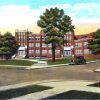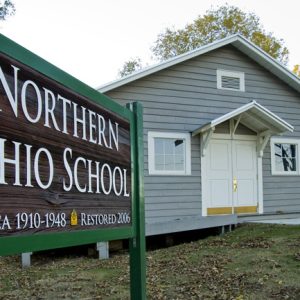calsfoundation@cals.org
Northern Ohio School
Until the mid-twentieth century, the majority of Arkansas children were taught in one-room schoolhouses, most of which were located in rural areas. Many of these schools have been destroyed, but several remain. The Northern Ohio School, a one-room schoolhouse for rural African-American students, is the only remaining one-room African-American schoolhouse in Parkin (Cross County).
As a result of the expanding lumber industry, the population of Parkin grew in the first decade of the twentieth century; the town was incorporated in 1912. The primary employers were local sawmills, one of which was the Northern Ohio Cooperage and Lumber Company. It formed in 1906 as an amalgamation of smaller sawmills: the Parkin Cooperage Company and the Northern Ohio Company. The gathering of residents who lived on the mill site of the Northern Ohio Cooperage and Lumber Company, just north of downtown Parkin, became known as the Sawdust Hill Community.
The Northern Ohio Cooperage and Lumber Company constructed a wood-framed, one-room schoolhouse around 1910 for the children of the company’s African-American workers. The mill employed workers within the sawmill as well as within a growing farming sector. The school was built on the northern edge of the Mississippian Parkin Historic Site, which the Northern Ohio mill occupied. This put the Northern Ohio School within easy walking distance of the mill community but was a farther walk for children of farm workers. The school taught students in the first through eighth grades.
Because food was scarce in the rural community during the Great Depression, a program was created in which the Northern Ohio School provided food to students and some local residents. The school continued until 1948. Two reasons account for the school’s closing: first, the closing of the Northern Ohio Cooperage and Lumber Company in 1946, and second, the consolidation with the Central Elementary School in 1948.
After its use as a schoolhouse, the Northern Ohio School building had several different functions. The building was partially used as a barn and was later converted into a private residence for the Ott family in the 1960s. When the property was acquired by the Arkansas Department of Parks and Tourism (ADPT), it was no longer recognizable as a school building, as portions of the original structure had been built over during the building’s transformation; for example, original chalkboards lay behind wood paneling. Research by employees at Parkin Archeological State Park revealed that the building was the Northern Ohio School. ADPT renovated the building to serve as a standing exhibit. The school building contains several artifacts contemporary to the time of its operation, including original lard, jelly, and molasses buckets.
The Northern Ohio School building, as well as the former site of the Northern Ohio Cooperage and Lumber Company, is protected as part of Parkin Archeological State Park. The Northern Ohio School was placed on the National Register of Historic Places on May 23, 2014.
For additional information:
Chowning, Robert W. History of Cross County, Arkansas. Wynne, AR: Wynne Progress, 1955.
“Northern Ohio School.” National Register of Historic Places nomination form. On file at Arkansas Historic Preservation Program, Little Rock, Arkansas. Online at http://www.arkansaspreservation.com/National-Register-Listings/PDF/CS0191.nr.pdf (accessed September 28, 2021).
“Northern Ohio School: Historic Structure Report and Stabilization Plan.” Prepared for the Arkansas Department of Parks and Tourism by Steelman, Connell, Mosely, Architects. Dean B. Ellis Library Archives and Special Collections. Arkansas State University, Jonesboro, Arkansas.
Oral History Interviews on the History of Sawdust Hill Community. On file at Parkin Archeological State Park, Parkin, Arkansas.
Zachary Elledge
Jonesboro, Arkansas
 Early Twentieth Century, 1901 through 1940
Early Twentieth Century, 1901 through 1940 Education, Elementary and Secondary
Education, Elementary and Secondary Historic Preservation
Historic Preservation Northern Ohio School
Northern Ohio School 




Comments
No comments on this entry yet.